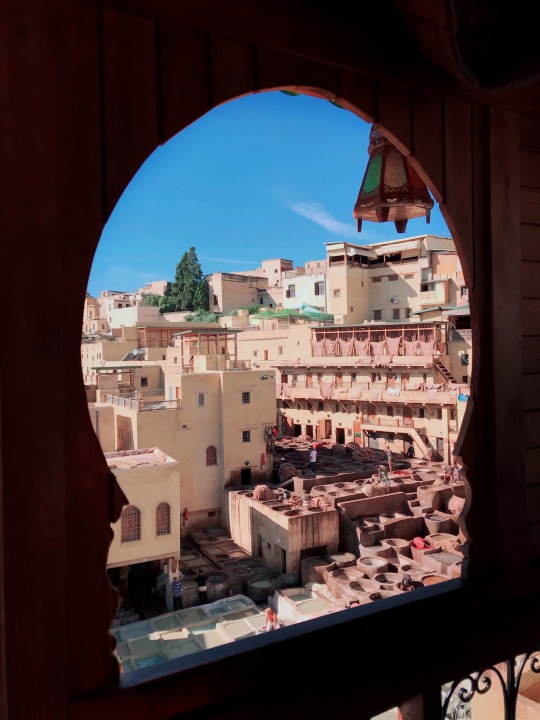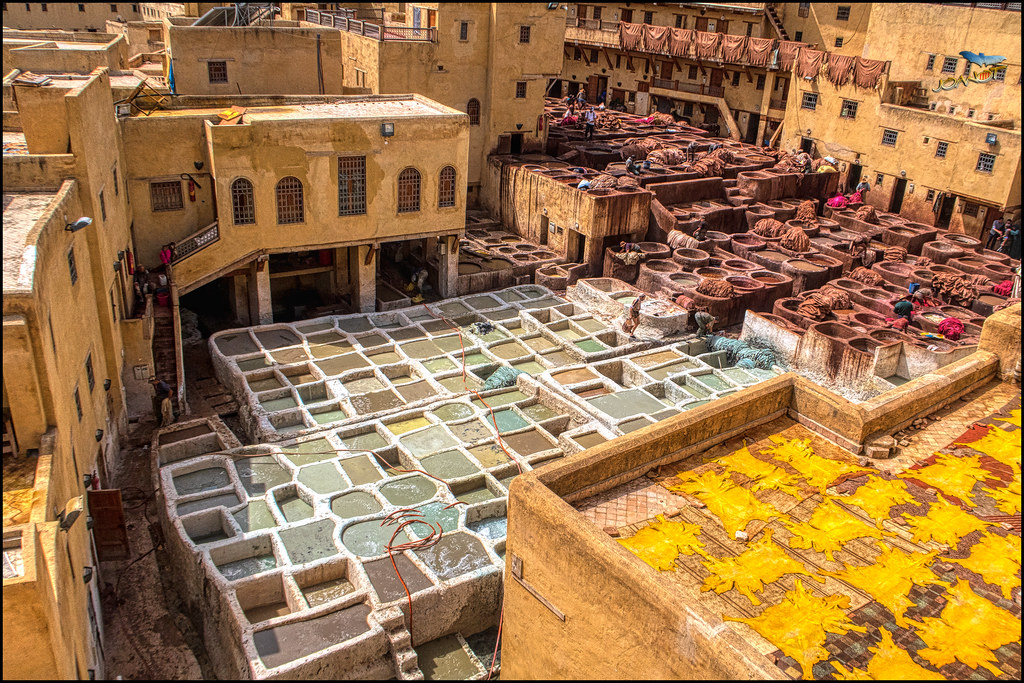#Chouara Tannery
Text
youtube
Tanners at the Chouara Tannery have been transforming animal hides into leather since the 11th century. The tanning process has gone unchanged since then, but it relies on heavy chemicals that threaten the health of workers. Some say they are not willing to take that risk. We traveled to the world’s oldest leather tannery in Fez, Morocco, to find out how this ancient craft is still standing.
MORE STILL STANDING VIDEOS:
Meet One Of The Last Masters Keeping Korea’s Ancient Onggi Tradition Alive | Still Standing
https://www.youtube.com/watch?v=kj8tG...
Why Only 1% Of Japan's Soy Sauce Is Made This Way | Still Standing
https://www.youtube.com/watch?v=MKbRu...
Egypt's Stone Carvers Keep Their Ancestors' Traditions Alive | Still Standing
https://www.youtube.com/watch?v=kKO6X...
------------------------------------------------------
#Morocco #StillStanding #BusinessInsider
#business insider#still standing#Solarpunk#leather tannery#leather#tannery#Tanners#Chouara Tannery#Fez#Morocco#Youtube
5 notes
·
View notes
Text
Travelogue: Blue City of Chefchaouen & Colourful Fes

View On WordPress
#Anji Chinese Resaurant#Anji Chinese Restaurant#Chefchaouen#Chouara Tannery#Dar Elrio#Duplex Steakhouse#Fes#Hercules Cave#holidays#Meknes#Morocco#Nejjarine Museum of Wooden Arts & Crafts#Palais Bahla Fes#Restaurant Nejjarine#travel#Travelogue
1 note
·
View note
Photo

So I visited the oldest leather tannery in the world 🌎 - Chouara Tannery! Considering I don’t know a thing about leather except that…again, PETA would be on me if they found out 😂…this was quite the experience. ………………………… After walking through several tiny little alleyways, my guide managed to get me into this leather shop to scope out some of the goods. I was also given a little tour of the place, that included a rooftop view of the tannery. Now, I have to be honest, this image might be very appealing, but be lucky you can see it’s beauty but not smell 👃🏾 it’s stench, because…BABY, it was rough! 😂 The reason being, the leather is actually cleaned with limestone and pigeon poop 💩. Yup, you read that right! Your fancy leather is cleaned with that stuff! Apparently, the limestone removes excess hair off the leather skin, while the pigeon poop softens the leather. Cleaning this leather is not a job for the faint hearted! ➡️ Are you a leather-lover? 👀 #beyondeden🌺 . . . . . #leather #Fez #morocco #discovermorocco #chouara #chouaratannery #tannery #blackwanderlust #agameoftones #FeselBali #Fezmedina #Africa #blackadventuristas #wegotoo #traveldiaries #traveller #blackgirlstraveltoo #meettheworld #huffpostgram #Iamatraveler #welltravelled #doyoutravel #worlderlust #fantastic_earth #simplymorocco #Medina #citywalk (at Chouara Tannery) https://www.instagram.com/p/CnVi8Gou1cQ/?igshid=NGJjMDIxMWI=
#beyondeden🌺#leather#fez#morocco#discovermorocco#chouara#chouaratannery#tannery#blackwanderlust#agameoftones#feselbali#fezmedina#africa#blackadventuristas#wegotoo#traveldiaries#traveller#blackgirlstraveltoo#meettheworld#huffpostgram#iamatraveler#welltravelled#doyoutravel#worlderlust#fantastic_earth#simplymorocco#medina#citywalk
0 notes
Text
Leather tanners in Morocco have been using time-honored techniques to tan animal hides for 1,000 years. But toxic chemicals are posing massive risks to the workers.
25 notes
·
View notes
Text
FES, MEKNÈS, CHEFCHAOUEN 🇲🇦 4 Days
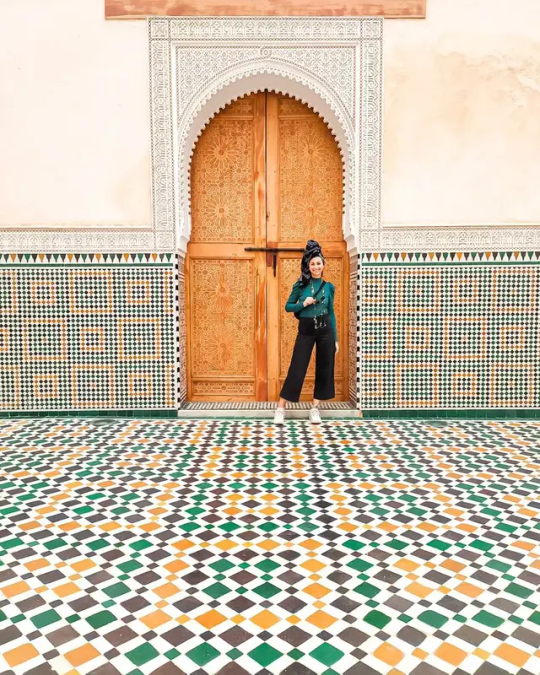
The oldest of the four "imperial cities" of Morocco (the others are Marrakech, Meknes and Rabat), Fes was the capital of Morocco several times in the past, the last of which ended in 1912, when most of Morocco came under French control and Rabat was chosen to be the capital of the new colony. Today Fes is the third largest city in Morocco after Casablanca and Rabat.
Fes is often referred to as the spiritual capital of Morocco. It was once one of the most important places of scholarship in the world, containing within its walls the bastion of Islamic teaching. The University of Al-Karaouine was founded in 859 AD and is the oldest continuously-operating university in the world.
WHAT TO VISIT
CHOUARA TANNERY
Colorful Moroccan slippers, bags, and jackets are just some of the leather goods available in Fes. But before shopping, be sure to check out the world-famous tanneries to see the traditional dying of animal skins

The ancient MEDINA
WATER CLOCK
UNIVERSITY
The Kairaouine Mosque is known to be the world’s oldest university and is the second-largest mosque in Morocco. It is one of the most important religious buildings in Fes, and as such, only Muslims are allowed inside.
Explore the SOUKS
The souks are the very soul of any Moroccan city, and the ones in Fes are some of the most impressive. Step back into a medieval time of dusty walled streets, where the only transport is donkey and cart. It’ll be an assault on the senses, with sellers shouting prices and striking hard bargains, aromatic smells coming from every direction, and textile displays in all colors of the rainbow.
NEJJARINE FONDOUK
Right amid Place Nejjarine, surrounded by metalworker workshops, you'll find the Nejjarine Museum in an old fondouk (khan or caravanserai), which has been transformed into a museum exhibiting the diversity of traditional Moroccan wooden arts and crafts
VISIT THE BAB BOUJELOUD (BLUE GATE)
The Bab Boujiloud is the iconic blue gate that marks the entrance to Fes el Bali (Old City). You can also check out the Bab Chorfa, another impressive gate framing the Medina.

WHERE TO STAY/WHERE TO EAT
We stayed at Riad Dar Omar
Here some places where to eat:
Cafè Clock
Restaurant Sahra
DAILY TRIPS FROM FES
MEKNÈS 📍
Only 65 kilometers southwest of Fes, and connected by regular trains, Meknes is a favorite day-tripping destination for visitors to the city.
This imperial city, made the ruling capital by Sultan Moulay Ismail in the 17th century, is home to a compact medina area that offers a more relaxed sightseeing experience than the crowded medinas of Fes and Marrakesh. This allows for easier viewing of the alleyway architecture.

Neighboring the medina is Meknes' imperial district, home to the grand Bab al-Monsour, one of the most ornate surviving gateways in North Africa, and the Mausoleum of Moulay Ismail, with its fine tile work and stucco-decorated interior.

Meknes is also the closest city to Volubilis, Morocco's best Roman-era ancient site. The rambling hilltop site, only 32 kilometers north of Meknes, is home to half-toppled temple buildings, still-standing columns along a colonnaded street, and intricate mosaic floors.
If you start early enough from Fes, it's easy to combine both in one day. Daily trip for 25€ each.
2. IFRANE NATIONAL PARK 📍
Ifrane National Park is located in the northcentral part of Morocco. It is situated in the central part of the Atlas mountain range. The park covers an area of 193.05 square miles (500 sq km).
The mountainous national park is blanketed in many parts with the Atlas cedar trees. Wetlands, high-altitude forests, and endemic habitats are part of what make the national park such a vital protected area.
The altitude of the park ranges from 4,590 to 7,874 (1,300 to 2,400 m) above sea level. The higher mountains are located in the neighboring Toubkal National Park which features the famous Mount Toubkal.
Approximately a tenth of the world’s population of Atlas Cedar is located here in the park. The ecosystem is also home to the endangered Barbary Macaque with approximately 25% of the entire global population found here in Ifrane. Daily trip for 25€ each.
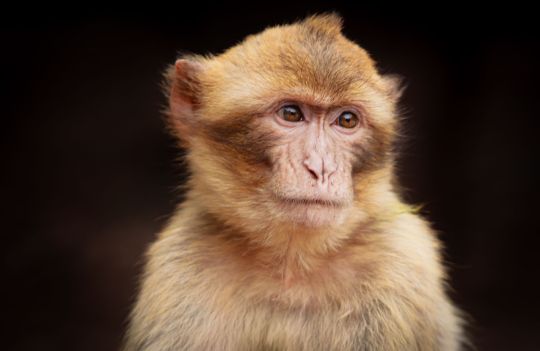
3. CHEFCHAOUEN 📍
Chefchaouen is a small town in Morocco with a rich history. Nestled in the Rif mountains, this old town is known for its beautiful surroundings and architecture, but what makes it stand out are the striking and varying shades of blue walls – it is one of The Most Colorful Cities Around The World.
Moulay Ali Ben Moussa founded the town of Chefchaouen in 1471. It began as a small fortress to fight the Portuguese invasions of Morocco. The Ghomara tribes, Moriscos, and Jews settled down in it after the Spanish Reconquista in 1492. Later, in 1920, Spain seized the old town, and it became a part of Spanish Morocco. Then, finally, Morocco declared its independence in 1956, and Chechaouen rejoined it once again.

The Reasons Why The City of Chefchaouen in Morocco is Entirely Blue:
The Jews
The color blue is representative of the sky according to Jewish belief. Jewish communities, therefore paint things blue and use blue-colored fabrics, especially prayer mats.
People believe that the Jewish refugees spread the blue fever to the entire ‘medina’ in 1930. The practice of painting walls blue was introduced by the Jews to stick to their religious practices. However, older residents say that the majority of the buildings within the medina used to be white until fairly recently. They stress that only the Jewish part of the medina used to be painted blue.
The Mosquitoes
A part of the residents believes that the blue shades repel mosquitoes. Their reasoning is that the insects do not like being in the water, although they live near the water. The blue walls almost look like flowing water, and they believe that this aspect keeps away the mosquitoes.
It is certainly possible that residents saw fewer mosquitoes in the Jewish part of the town, and so they decided to attribute it to the color and paint their houses blue as well.
Daily Trip from Fes for 30€ each.
0 notes
Text

Chouara Tannery in the medina of Fez, Morocco. Wandering through the vast Fez medina it would be easy to miss the tanneries but they offer an interesting glimpse into times gone by - with a process little changed since medieval times. Stone vats are filled with a somewhat toxic mixture of lime, salt, cow urine, and water to soften the leather over a period of days before dye is applied. As well as cow, sheep and goat skin, camel leather is also common here. Natural plant and mineral colours such as indigo and henna are used to tan the hides which are then sun dried. Many of the resulting leather products are made locally by hand in the medina and sold by local merchants. It's common to experience quite an aggressive sales pitch on approach to the tannery!
See more -
0 notes
Text
Morocco tour,
Morocco tour,
Title: Experience the Rich Cultural Tapestry and Natural Wonders of Morocco
Introduction:
Morocco, a captivating country nestled in North Africa, offers a remarkable blend of history, culture, and breathtaking landscapes. From the vibrant markets of Marrakech to the magnificent Sahara Desert and the picturesque Atlas Mountains, Morocco beckons travelers with its alluring charm. Embarking on a tour of Morocco promises an unforgettable adventure, where ancient traditions meet modern experiences. Join us as we delve into the enchanting world of Morocco, uncovering its diverse wonders and hidden treasures.
The Allure of Imperial Cities:
Morocco's imperial cities, including Marrakech, Fez, Rabat, and Meknes, are a testament to the country's rich history. Each city boasts its own unique architectural splendor, bustling medinas, and intricate palaces. Explore the narrow, labyrinthine streets of Marrakech's medina, where vibrant souks (markets) offer an array of colorful spices, textiles, and handicrafts. Marvel at the stunning Bahia Palace and the iconic Koutoubia Mosque. In Fez, wander through the world's largest car-free urban zone, where centuries-old traditions thrive. Don't miss the beautifully preserved Bou Inania Madrasa and the famous Chouara Tannery.
Sahara Desert: A Desert Adventure:
No trip to Morocco is complete without venturing into the majestic Sahara Desert. Embark on a captivating journey, traversing the vast golden dunes on the back of a camel, and witness mesmerizing sunrises and sunsets that paint the sky with vivid hues. Spend a night in a traditional desert camp, immersing yourself in Berber culture and savoring delicious Moroccan cuisine under a blanket of stars. Whether it's sandboarding down the dunes or simply basking in the tranquility of the desert, the Sahara promises a once-in-a-lifetime experience.
Magnificent Atlas Mountains:
Morocco's Atlas Mountains offer a breathtaking backdrop of rugged peaks, verdant valleys, and picturesque Berber villages. Embark on a trek through the High Atlas, where you'll encounter stunning vistas and encounter warm-hearted locals. Explore the charming village of Imlil, a gateway to Mount Toubkal, the highest peak in North Africa. Immerse yourself in Berber culture, enjoy traditional mint tea, and indulge in authentic cuisine. The Atlas Mountains provide ample opportunities for hiking, skiing, and mountain biking, catering to both adventure enthusiasts and nature lovers.
Coastal Charms:
Morocco's coastline is dotted with beautiful beaches and charming coastal towns. Visit Essaouira, a UNESCO World Heritage Site, renowned for its ancient medina, vibrant fishing harbor, and captivating blue and white architecture. Stroll along the picturesque corniche and enjoy fresh seafood while soaking up the laid-back atmosphere. Further along the coast, you'll find Casablanca, Morocco's cosmopolitan city, where modernity meets tradition. Admire the iconic Hassan II Mosque, one of the largest mosques in the world, and explore the lively medina.
Cultural Melting Pot:
Morocco's rich cultural heritage is a tapestry woven with influences from Arab, Berber, and European civilizations. Experience the vibrancy of Moroccan music and dance, with the sounds of traditional Gnawa music filling the air and the mesmerizing movements of belly dancers. Sample a diverse array of flavors, from aromatic tagines to mouthwatering couscous. Take part in a traditional Moroccan cooking class and learn the secrets of preparing delectable dishes. Immerse yourself in local customs and traditions, such as visiting a Hammam (traditional bathhouse) for a rejuvenating experience.
Conclusion:
A journey through Morocco is a sensory adventure that unve
0 notes
Photo

Chouara Tannery, the oldest and one of the three tanneries in the city of Fes. #Morocco 🇲🇦 . . 👉 Follow @toursofmorocco for more inspiration! . .📸 by @celestebaldanzi . ╚»★«╝ To Be Feardred ╚»★«╝ ✔ 1. 𝐅𝐨𝐥𝐥𝐨𝐰 𝐮𝐬 @toursofmorocco ✔ 2. 𝐓𝐚𝐠 𝐮𝐬 𝐨𝐫 𝐮𝐬𝐞 #toursofmorocco . 🌐: MoroccoToursAgency.com 📧: [email protected] . .#travelworld #travelblogger #travelpic #traveltheworld #travelcouple #travelgram #travelguide #travelblog #traveling #instatravel #ergchebbi #merzouga #saharadesert #ergchebbidesert #travel #instatraveling #travelers #traveler #travelphoto #beauty #adventure #travelagent #travelguide #marrakesh #luxury #luxurylifestyle #leisur (at Tannery, Fes Medina, Fes Morocco) https://www.instagram.com/p/CdaeiVZjsv9/?igshid=NGJjMDIxMWI=
#morocco#toursofmorocco#travelworld#travelblogger#travelpic#traveltheworld#travelcouple#travelgram#travelguide#travelblog#traveling#instatravel#ergchebbi#merzouga#saharadesert#ergchebbidesert#travel#instatraveling#travelers#traveler#travelphoto#beauty#adventure#travelagent#marrakesh#luxury#luxurylifestyle#leisur
0 notes
Link
5 notes
·
View notes
Video
1981- Chouara Tannery (Fez) Morocco by Joanot Bellver
Via Flickr:
Chouara Tannery, softening liquid on top and dye on bottom (Fez) Morocco
1 note
·
View note
Photo
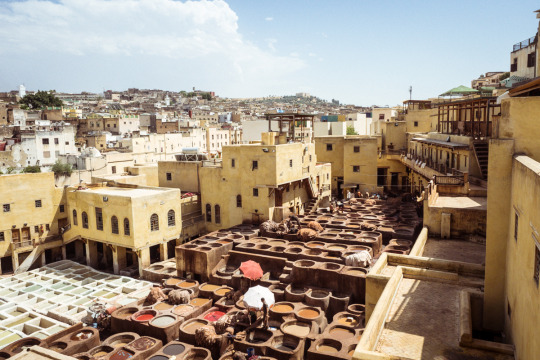


Chouara Tannery.
Fes, Morocco. 2019.
#fes#morocco#tannery#africa#brettjordanphoto#adventuresofbrettandanita#thejordanstakeeurope#chouara tannery
0 notes
Text
Sunday, April 21, 2019
We woke up on the skinny couches, and went down to meet our hosts to bring us to the actual place we were staying tonight. We had breakfast made for us and then were bought to our room for the night.
After we dropped our bags off and got ready for the day we ventured out into the maze of Fes’ medina. Hoping this time, since it was day light, we wouldn’t run into any trouble and would get comfortably lost. We really didn’t have much of an agenda, other than find the tanneries and pop into shops and look around.
We stopped at Al-Attarine Madrasa. A madrasa is the Arabic word for an educational institution, where religious or non-religious materials are learned. Islamic architecture is truly beautiful.
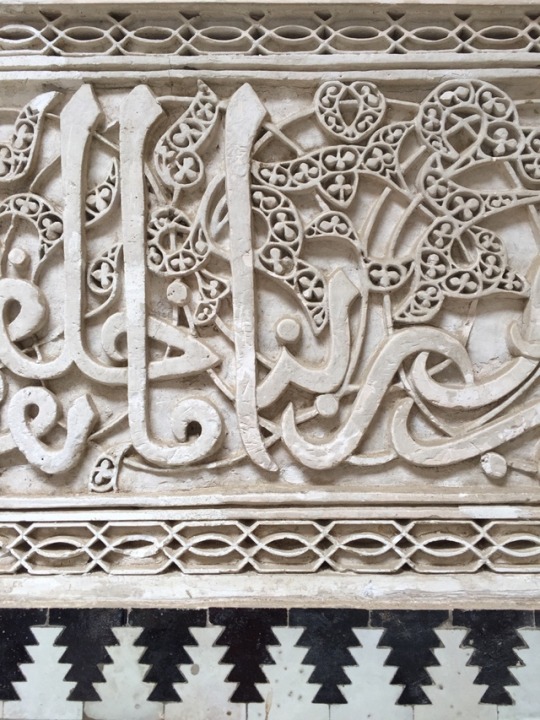
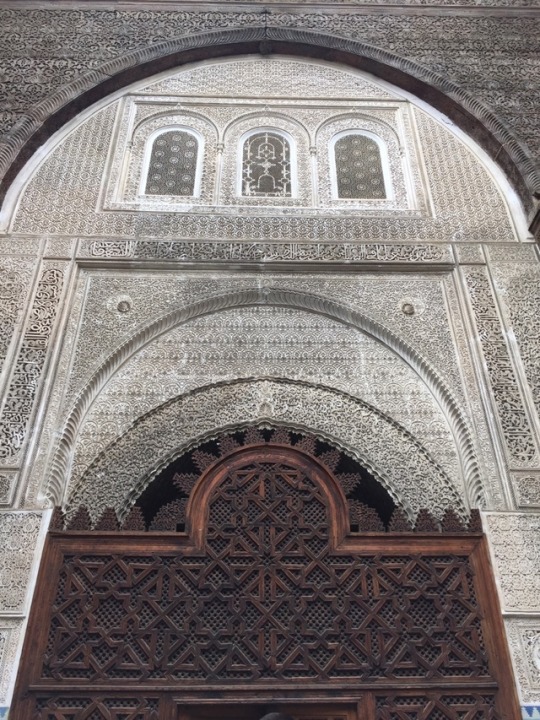
We started our journey to find the tanneries. The old medina of Fes are a labyrinth. It would take 2.5 seconds for you to lose your way. But somehow everyone knows where they’re going. Well, obviously except Evan and I. The old medina is the best preserved and car free city in the Arab world. Mind you, I’m doing all this walking in sandals because my sneakers are still completely drenched from our trip to Volubilis.
After getting turned around 27 times, we finally found our way to the Chouara Tanneries. We went on a couple of roofs to look out over the tanneries. Upon getting to the roof, we were given mint leaves, which we would become aware of why once we stepped onto the roof.
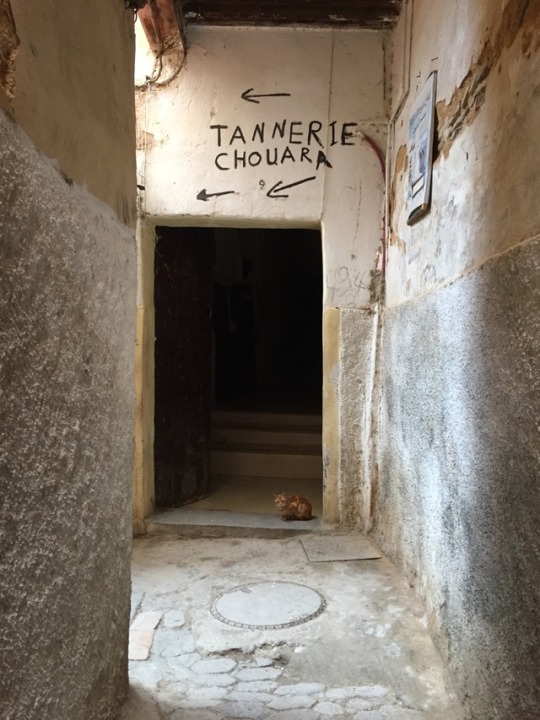
The Chouara Tannery is one of three tanneries in Fes, it’s also the largest tannery in the city. We learned that the dyes were mixed with pigeon droppings because they naturally contain ammonia and help soften the animal hides. It was really interesting to watch the men at work washing and dying the hides. I can only imagine the labor that goes into that work, also..the smell, I’m not sure you’d ever really get used to it.. which is why we were given the mint.. We hopped around to a couple of different roofs to get different views. The colors were so beautiful.

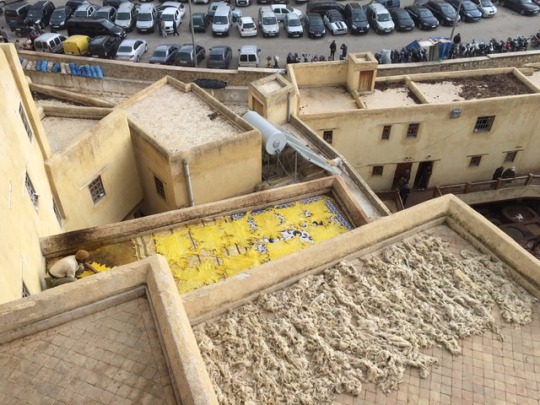



Leaving the tanneries meant diving back into the maze. We ended up walking through a bakery area and were actually given free tastes of cookies. Which was a nice change of pace.
We ended up at Place R’Cif, which is the heart of the medina and the home of one of the tallest minarets in Fes. We walked around the market for a bit and then walked back into the chaos and stumbled upon Madrassa Achartine, we walked around for a bit inside.


Then we broke for lunch. We found a tasty little spot. It was nice to be off our feet for a bit.
Then it started to rain a bit, but nothing too bad, at least we both had our rain coats at this time. We visited Palais Mnebhi, and went up to the roof, which put us above most of the city. And we actually got to be up there during a call to prayer, which was really cool because you could hear all the different voices and calls coming from the different minarets in different parts of the city.
After we left the palais it really began to pour. But we continued to shop. We eventually started to get soaked and decided we had had enough and stopped for tea so we could stay dry. We stayed for about 40 minutes and then decided to brave the rain and get back to the riad to drop off our stuff.
We went back out to grab a late night snack and have a glass of wine. We had found a restaurant which served and we wanted to celebrate surviving Fes. So we got there, ordered some fries and a bottle of red wine. When he came over to pour the wine for us, he asked me to keep the bottle on the foot behind the table. Which was weird, and Evan and I were like.. did we just stumble upon a speakeasy in Fes 😅 ...but we definitely did. A group of girls sat at the table behind us, and they all ordered beers and when they were brought over to the table, Evan said he overheard their conversation with the waiter. The waiter began to pour their beers into a glass and they asked if they could just drink out of the bottle and the waiter apologized and said no, “because as long as the beer is in a glass it looks like apple juice” to people walking by. 😂
Once we finished we walked back to our riad to take a hot shower, which we so clearly deserved.... but the water was like ice daggers and I refused to shower. These last couple of days in Fes man... they’ve sure been interesting.
Evan wrote in a post on Facebook:
The somewhat organized chaos of Fes was an interesting way to spend the last couple days of our trip. The old medina is the best preserved old city in the Arab world and is also the world's largest car-free urban area. The narrow, winding streets of the medina are chaotic and confusing, and they only got worse with the rain. That said, the skies cleared up just long enough for us to experience the beauty of the Chouara Tannery.
#morocco#morc#travel#travel blog#travel photography#fes#medina#ch#tanneries#chouara tannery#landscape
0 notes
Photo

[ Chouara Leather Tanneries · Fes El Bali ]
·
Numerous stone vessels filled with a vast range of dyes and various liquids spread out like a tray of watercolors.
·
Dozens of men, many standing waist deep in dyes, work under the hot sun tending to the hides that remain soaked in the vessels.
·
Hides are first soaked for two to three days in a mixture of cow urine, quicklime, water, and salt. This caustic mixture helps to break down the tough leather, loosen excess fat, flesh, and hair that remain on them.
·
The hides are then soaked in another set of vats containing a mixture of water and pigeon poop, which contains ammonia that acts as softening agent and allows the hides to become malleable so they can absorb the dye.
·
The tanner uses his bare feet to knead the hides for up to three hours to achieve the desired softness.
#azar studio#azarstudio#leather#tanneries#fes#morocco#artisanal#artisan life#leather work#craftsmanship#history#dyers#tannery#chouara#research#ethical#ethical consumerism#conscious consumption#x2
4 notes
·
View notes
Photo

La Conceria di Fes #tannery #conceria #fes #marocco #moroccotravel #chouara #chouaratannery #morocco #scuoladiviaggio @scuoladiviaggio www.scuoladiviaggio.it (presso Chouara Tannery) https://www.instagram.com/p/Bwldnp7hx1m/?utm_source=ig_tumblr_share&igshid=vehya9qxbycd
1 note
·
View note
